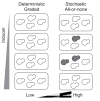Recent Progress on Systems and Synthetic Biology Approaches to Engineer Fungi As Microbial Cell Factories
- PMID: 27226765
- PMCID: PMC4864837
- DOI: 10.2174/1389202917666151116212255
Recent Progress on Systems and Synthetic Biology Approaches to Engineer Fungi As Microbial Cell Factories
Abstract
Filamentous fungi are remarkable organisms naturally specialized in deconstructing plant biomass and this feature has a tremendous potential for biofuel production from renewable sources. The past decades have been marked by a remarkable progress in the genetic engineering of fungi to generate industry-compatible strains needed for some biotech applications. In this sense, progress in this field has been marked by the utilization of high-throughput techniques to gain deep understanding of the molecular machinery controlling the physiology of these organisms, starting thus the Systems Biology era of fungi. Additionally, genetic engineering has been extensively applied to modify wellcharacterized promoters in order to construct new expression systems with enhanced performance under the conditions of interest. In this review, we discuss some aspects related to significant progress in the understating and engineering of fungi for biotechnological applications, with special focus on the construction of synthetic promoters and circuits in organisms relevant for industry. Different engineering approaches are shown, and their potential and limitations for the construction of complex synthetic circuits in these organisms are examined. Finally, we discuss the impact of engineered promoter architecture in the single-cell behavior of the system, an often-neglected relationship with a tremendous impact in the final performance of the process of interest. We expect to provide here some new directions to drive future research directed to the construction of high-performance, engineered fungal strains working as microbial cell factories.
Keywords: Fungal engineering; Regulatory networks; Synthetic biology; Synthetic promoters.; Systems biology.
Figures




Similar articles
-
Engineering Complexity in Bacterial Regulatory Circuits for Biotechnological Applications.mSystems. 2018 Apr 10;3(2):e00151-17. doi: 10.1128/mSystems.00151-17. eCollection 2018 Mar-Apr. mSystems. 2018. PMID: 29657966 Free PMC article.
-
Systems and Synthetic Biology Approaches to Engineer Fungi for Fine Chemical Production.Front Bioeng Biotechnol. 2018 Oct 3;6:117. doi: 10.3389/fbioe.2018.00117. eCollection 2018. Front Bioeng Biotechnol. 2018. PMID: 30338257 Free PMC article. Review.
-
Considerations for Domestication of Novel Strains of Filamentous Fungi.ACS Synth Biol. 2025 Feb 21;14(2):343-362. doi: 10.1021/acssynbio.4c00672. Epub 2025 Jan 30. ACS Synth Biol. 2025. PMID: 39883596 Free PMC article. Review.
-
Modular Synthetic Biology Toolkit for Filamentous Fungi.ACS Synth Biol. 2021 Nov 19;10(11):2850-2861. doi: 10.1021/acssynbio.1c00260. Epub 2021 Nov 2. ACS Synth Biol. 2021. PMID: 34726388 Free PMC article.
-
Boosting Secondary Metabolite Production and Discovery through the Engineering of Novel Microbial Biosensors.Biomed Res Int. 2018 Jul 9;2018:7021826. doi: 10.1155/2018/7021826. eCollection 2018. Biomed Res Int. 2018. PMID: 30079350 Free PMC article. Review.
Cited by
-
A Novel Cys2His2 Zinc Finger Homolog of AZF1 Modulates Holocellulase Expression in Trichoderma reesei.mSystems. 2019 Jun 18;4(4):e00161-19. doi: 10.1128/mSystems.00161-19. mSystems. 2019. PMID: 31213522 Free PMC article.
-
Synthetic and minimalist vectors for Agrobacterium tumefaciens-mediated transformation of fungi.Genet Mol Biol. 2019 Apr-Jun;42(2):395-398. doi: 10.1590/1678-4685-GMB-2018-0221. Epub 2019 Jun 13. Genet Mol Biol. 2019. PMID: 31259357 Free PMC article.
-
Tuning fungal promoters for the expression of eukaryotic proteins.World J Microbiol Biotechnol. 2024 Dec 2;40(12):400. doi: 10.1007/s11274-024-04198-2. World J Microbiol Biotechnol. 2024. PMID: 39617818 Review.
-
Blocking utilization of major plant biomass polysaccharides leads Aspergillus niger towards utilization of minor components.Microb Biotechnol. 2021 Jul;14(4):1683-1698. doi: 10.1111/1751-7915.13835. Epub 2021 Jun 11. Microb Biotechnol. 2021. PMID: 34114741 Free PMC article.
-
The art of vector engineering: towards the construction of next-generation genetic tools.Microb Biotechnol. 2019 Jan;12(1):125-147. doi: 10.1111/1751-7915.13318. Epub 2018 Sep 26. Microb Biotechnol. 2019. PMID: 30259693 Free PMC article. Review.
References
LinkOut - more resources
Full Text Sources
Other Literature Sources
Research Materials
Miscellaneous
